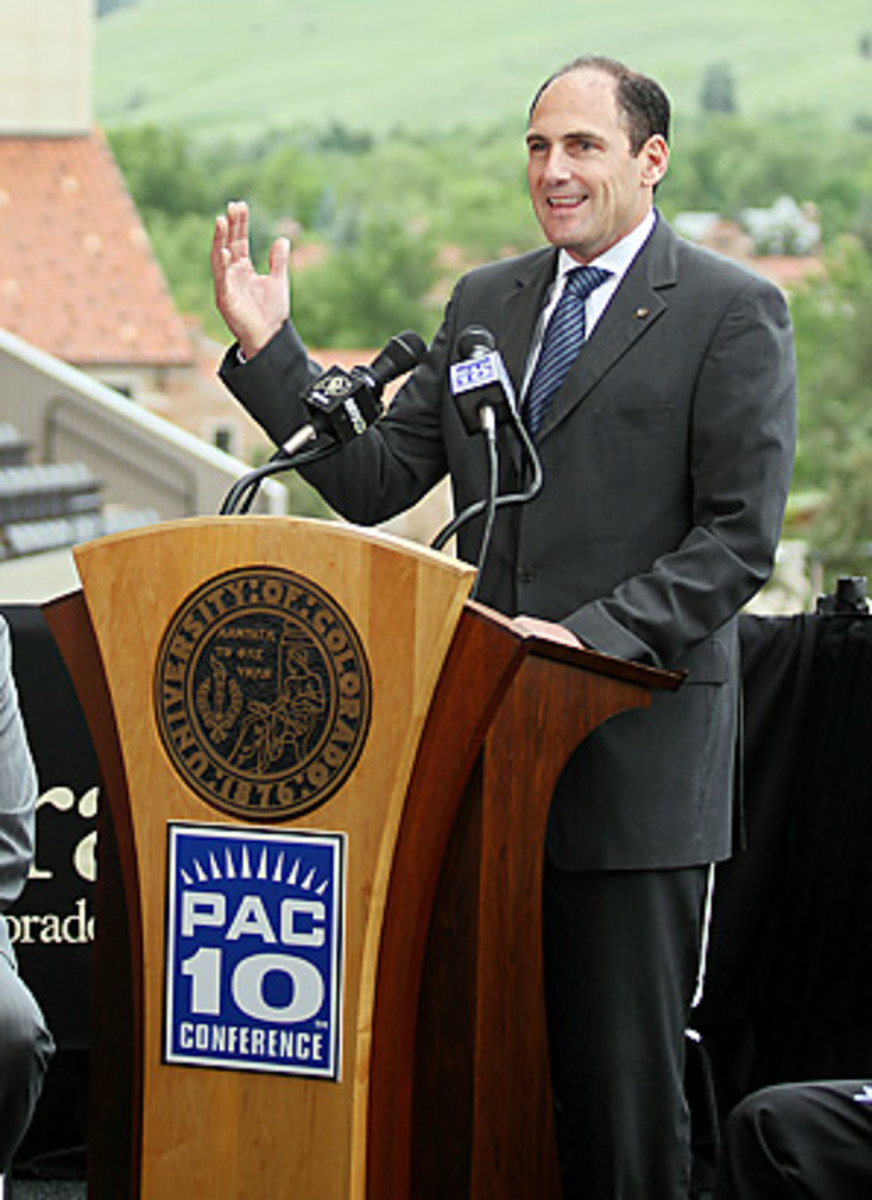
Superconference idea not dead
The Pac-10 came within days of making a move that would have reshaped college athletics. Commissioner Larry Scott didn't succeed last month in landing Texas, Oklahoma, Texas A&M, Oklahoma State and Texas Tech, but he believes the idea of 16-team superconferences took root in the minds of many influential people, and he expects to see them eventually.
Will the first megaconference be the league currently known as the Pac-10, which will rechristen itself the Pac-12 when new members Colorado and Utah join?
"We're done -- for now," Scott said.
Scott said "for now" because he believes his league will remain stable after it signs a new set of media contracts next year. Since most recent contracts have been long-term -- the SEC is in the first year of 15-year deals with CBS and ESPN, and the ACC just signed a 12-year deal with ESPN -- Scott expects his league to go down a similar path. That doesn't preclude the idea of adding schools, but it does make it less likely.
Still, Scott said there was far too much "head-nodding" among the major players in college sports to believe that the idea of a 16-team league is dead. "Something like that is bound to happen at some stage," he said.
Scott was ambitious when he moved last year from the Women's Tennis Association to the Pac-10, but as he researched potential expansion alternatives, a paradigm-shifting move began to make sense. "Our original idea for involving some Big 12 South schools did not involve six of them," Scott said. "We had some early conversations with Texas about the process, but I realized that there would be some real challenges and some stumbling blocks with some of the earliest ideas we discussed. Over a period of about four months, we developed the idea that which fans got a chance to see during that period in June."
Scott didn't know initially how the idea would be received, but when he got the endorsement of Pac-10 presidents, he knew it had a chance. The happiest surprise, he said, came from television executives. "What you couldn't predict is what fan reaction would be, what media reaction would be and how the TV executives who would ultimately have to stroke some big checks would react," Scott said. "That was the part that was very pleasing. I got contacted by every major TV network in the country."
When rumors began to fly that Fox had the inside track on a deal with the new conference, Scott said, representative of the other networks called asking Scott to hear their pitches before he made a decision. The Fox rumors weren't true, but they did help Scott learn just how valuable that 16-school alignment would be.
The potential move set off alarm bells in other quarters of the sport. At schools such as Kansas and Kansas State, which could have fallen from the elite level in a drastic reorganization, there was outright panic. At the NCAA level, some worried such an obviously money-motivated move would further harm the NCAA's efforts to maintain amateurism. Big 12 commissioner Dan Beebe, who was trying to save his league, even posited in an internal white paper that the move might prompt the federal government to consider revoking the NCAA's tax-exempt status.
One of the presidents who approved Scott's expansion plan said conferences have been in flux for a long time, and consolidation might be the next logical step. "I know there's a tendency for folks to say this is all about money," Washington president Mark Emmert said. "Obviously, money is very important in all this, but it wasn't just all about money. We wanted to make sure that we had institutions that would fit well and that would accept the culture we created in the Pac-10."
Emmert's opinion is important. On Nov. 1, he'll take over as president of the NCAA. He said consolidation doesn't have to be all about dollars. "With any of these alignments and realignments, the one thing that we in intercollegiate athletics -- and when I say we, I mean the presidents, the commissioners, me in my NCAA role, all of us - have to worry about is that we keep our eye on the ball here that this is about creating ever-improving and better opportunities for student-athletes," Emmert said. "It's very easy to get caught up in a media contract or this alignment or that alignment. As long as we constantly say, 'How does this change positively the experience kids can have on the playing field?' If we keep our eye on that, then these expansions could be very positive. It could be a lot of fun."
The schools that wind up on the other side of the revenue divide may not consider it a lot of fun, but they may have little choice in the matter. If powerful schools want to consolidate, and if television networks want to pay them a lot of money to do it, nothing can stop the superconferences from forming.
"I've got a pretty simple philosophy on these things," Scott said. "If things make sense, I think they ultimately happen. Maybe not in the time frame that people would wish, but this one just seemed to make an awful lot of sense to a lot of people and seemed to have tremendous amount of value associated with it."





